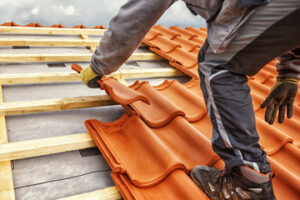There are many decisions to be made when re-roofing a home or business. One of the biggest is deciding which roofing materials to use. Contact Roofing Louisiana for professional help.

Start by taking precise measurements of the roof. Record these in a notepad to keep track of them. Don’t round up or down; this will throw off your calculations later on.
The cost of roofing installation can vary depending on the size, material type and complexity of the roof. It also depends on the climate where you live and the availability of certain materials. For instance, areas with harsh weather conditions require special roofing materials to cope with extreme temperatures and heavy rain or snowfall.
Labor is usually the biggest expense in a roofing project. It takes time and effort to install shingles, tar, underlayment, felt paper, and other required materials. The roofers’ rates are also dependent on their experience, reputation, and the type of roofing materials used. For example, premium materials like tile and slate are more expensive than asphalt shingles.
Other significant expenses are flashing and vents. The flashing is a thin piece of metal that covers vulnerable joints and cracks in the roof structure. It’s installed in the valleys of the roof and around chimneys. It protects the roof from leaks and adds a decorative touch to the exterior of the home. Similarly, the vents are placed in the attic to remove moisture and heat, which helps regulate the temperature and reduce energy costs.
The best way to know the cost of re-roofing is by getting quotes from several contractors in your area. The quotes will include the estimated price for materials and the labor. However, it is important to understand that the estimates are only approximate and may change during the course of the work. The contractor will discuss the final estimate with you before beginning any work.
Materials
A roofer needs to have a variety of materials to complete a roofing project. The specifics vary by the type of roof being installed and the climate where it is located. The roofing material may also determine the design and structure of a home.
A typical roofing installation starts with a base layer called sheathing, usually plywood or OSB, that serves as the substrate for the new roofing material. Sheathing also protects the interior of a home from water damage. Depending on the project, sheathing might need to be replaced during a roof replacement or repair.
The next layer is the underlayment. Roofers use a variety of underlayment, including felt paper, tar paper, or cellulose insulation. A felt paper underlayment typically has a lightweight, flexible construction. It is designed to withstand heavy rainfalls and high wind speeds. It also resists fire and mold. Other underlayment options include modified bitumen membranes and single-layer membranes. These are typically made from neoprene, EPDM, PVC, or chlorinated polyethylene.
Shingles are a popular choice for residential and commercial roofs. They provide an affordable, attractive and durable roof covering. Shingles are available in a range of colors and styles, but asphalt shingles are the most common. Other types of shingle include wood shakes and slate. Shakes are thicker wedges of wood, while shingles are thinner slabs.
Tile roofs are another popular option for homes. Clay and concrete tiles add a distinctive look to a home, and they are long-lasting and non-combustible. However, they are expensive and can add weight to a building, making it less energy-efficient.
Other roofing materials include metal, solar shingles and foam-based products. Roofing professionals can advise on the best type of roof for a building based on budget, location and style preferences.
In addition to these important roofing materials, a roofer needs a variety of tools and safety equipment to work on a jobsite. Tools for the job site include a tape measure, a handsaw and a ladder. Roofers also need safety equipment, such as a hard hat, eye protection, gloves and knee pads. Lastly, a roofer must have a work vehicle that can transport the materials and tools to the jobsite.
Labor
A new roof is a major investment for any homeowner. They’ll want to know how much it will cost before they sign a contract.
Include labor costs in your bid. This will vary depending on the complexity of the project, and any unforeseen circumstances like weather conditions. Be sure to also factor in the amount of time spent preparing the roof for installation, including items like tarping.
If you’re a general contractor, add in your overhead and markup for organizing and supervising the Panel Roofing Installation project. Your markup is how you cover your operating expenses, and earn a profit.
Other costs to consider include sales tax and any other fees charged by the local government for the overall project. It’s also important to include any warranty information. A customer who sees that you’re backed by a strong warranty will be more likely to invest in your services. Testimonials are also a great way to show potential clients what other people think of your work.
Final Walkthrough
A final walkthrough is an important part of the homebuying process. It’s typically done after a home has been re-roofed and gives buyers the opportunity to verify that the roof was completed as expected in the purchase agreement. Usually, the seller and seller’s agent aren’t present during the walkthrough, which allows the buyer and their agent to fully assess the property.
This is a great time to check for any issues that were missed during the initial inspections. For example, if the original roofers neglected to cut down trees or run wires through walls for TV boxes and speakers, it’s likely that these items will show up during the final walkthrough and need to be resolved. It’s also a good time to discuss any additional repairs that may be needed after the close of sale.